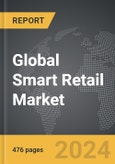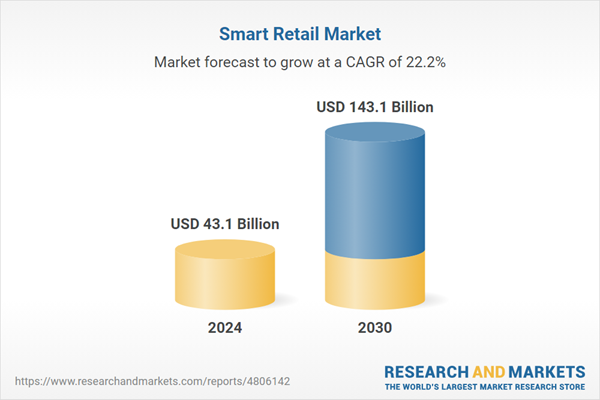The global market for Smart Retail was valued at US$43.1 Billion in 2024 and is projected to reach US$143.1 Billion by 2030, growing at a CAGR of 22.2% from 2024 to 2030. This comprehensive report provides an in-depth analysis of market trends, drivers, and forecasts, helping you make informed business decisions. The report includes the most recent global tariff developments and how they impact the Smart Retail market.
Segments: Component (Hardware, Software); Application (Visual Marketing, Intelligent System, Smart Payment System, Smart Label, Other Applications).
Geographic Regions/Countries: World; USA; Canada; Japan; China; Europe; France; Germany; Italy; UK; Rest of Europe; Asia-Pacific; Rest of World.
The analysts continuously track trade developments worldwide, drawing insights from leading global economists and over 200 industry and policy institutions, including think tanks, trade organizations, and national economic advisory bodies. This intelligence is integrated into forecasting models to provide timely, data-driven analysis of emerging risks and opportunities.
Global Smart Retail Market - Key Trends & Drivers Summarized
What Is Smart Retail and How Is It Transforming Shopping Experiences?
Smart retail refers to the integration of advanced digital technologies into traditional retail settings to enhance both operational efficiencies and customer experiences. At its core, smart retail employs IoT devices, artificial intelligence (AI), big data analytics, and augmented reality (AR) to create a seamless, personalized shopping journey. This technology-driven approach helps retailers understand consumer behaviors at a granular level, allowing them to tailor products, services, and promotions to individual preferences and historical data. Smart shelves, for instance, not only monitor inventory in real time but also gather data on shopper interactions with products, providing insights that can lead to better stock management and personalized marketing. Additionally, smart retail facilitates the use of mobile checkout processes, interactive kiosks, and virtual fitting rooms, significantly enhancing the in-store customer experience and reducing friction points.How Does Technology Propel Operational Excellence in Smart Retail?
The deployment of AI and machine learning algorithms marks a significant milestone in the evolution of smart retail. These technologies automate complex processes such as demand forecasting, pricing optimization, and customer service management, leading to increased accuracy and operational efficiency. AI-powered chatbots and virtual assistants provide 24/7 customer service, handling inquiries and resolving issues faster than traditional methods. Moreover, the integration of blockchain technology ensures transparency and security in transactions, building trust among consumers. Data analytics play a pivotal role as well, enabling retailers to extract valuable insights from large volumes of consumer data, which can be used to optimize supply chains, enhance product placements, and predict future buying patterns. These technological advancements collectively reduce costs, increase sales, and improve the overall health of retail operations.What Trends Are Shaping the Future of Smart Retail?
Several trends are currently shaping the future of smart retail, each driven by technological advancements and changing consumer expectations. One of the most significant trends is the rise of omnichannel retailing, where the distinction between online and offline shopping blurs, creating a cohesive customer experience across multiple platforms. This model relies heavily on technology to ensure that inventory and pricing information is consistent across all channels. Another trend is the increasing use of AR and VR to enhance the physical retail experience, allowing customers to visualize products in their own space or try on clothes virtually before making a purchase. Additionally, the growing emphasis on sustainability has led to the adoption of smart technologies that minimize waste and improve energy efficiency within retail operations. These trends not only cater to the immediate needs of consumers but also address broader societal concerns, making smart retail a dynamic and evolving field.What Drives the Growth in the Smart Retail Market?
The growth in the smart retail market is driven by several factors that reflect the changing landscape of technology, consumer behavior, and economic conditions. Technological innovations, such as AI, IoT, and big data analytics, are crucial as they provide the backbone for creating efficient and personalized shopping experiences. Consumer demand for convenience, speed, and personalization in shopping experiences influences retailers to adopt smart technologies that meet these expectations. Moreover, the COVID-19 pandemic accelerated the adoption of contactless services and digital solutions in retail, a trend that is likely to continue post-pandemic. The economic benefits associated with smart retail, including reduced operational costs and increased sales through targeted marketing and optimized stock management, also contribute to its growth. Additionally, as consumers become more tech-savvy, there is a natural progression towards embracing digital solutions in retail settings, further driving the market forward. These drivers ensure the sustained relevance and expansion of smart retail in the global market.Report Scope
The report analyzes the Smart Retail market, presented in terms of units. The analysis covers the key segments and geographic regions outlined below.Segments: Component (Hardware, Software); Application (Visual Marketing, Intelligent System, Smart Payment System, Smart Label, Other Applications).
Geographic Regions/Countries: World; USA; Canada; Japan; China; Europe; France; Germany; Italy; UK; Rest of Europe; Asia-Pacific; Rest of World.
Key Insights:
- Market Growth: Understand the significant growth trajectory of the Visual Marketing segment, which is expected to reach US$5.8 Billion by 2030 with a CAGR of a 19.1%. The Intelligent System segment is also set to grow at 21.4% CAGR over the analysis period.
- Regional Analysis: Gain insights into the U.S. market, valued at $10.6 Billion in 2024, and China, forecasted to grow at an impressive 23.9% CAGR to reach $20.2 Billion by 2030. Discover growth trends in other key regions, including Japan, Canada, Germany, and the Asia-Pacific.
Why You Should Buy This Report:
- Detailed Market Analysis: Access a thorough analysis of the Global Smart Retail Market, covering all major geographic regions and market segments.
- Competitive Insights: Get an overview of the competitive landscape, including the market presence of major players across different geographies.
- Future Trends and Drivers: Understand the key trends and drivers shaping the future of the Global Smart Retail Market.
- Actionable Insights: Benefit from actionable insights that can help you identify new revenue opportunities and make strategic business decisions.
Key Questions Answered:
- How is the Global Smart Retail Market expected to evolve by 2030?
- What are the main drivers and restraints affecting the market?
- Which market segments will grow the most over the forecast period?
- How will market shares for different regions and segments change by 2030?
- Who are the leading players in the market, and what are their prospects?
Report Features:
- Comprehensive Market Data: Independent analysis of annual sales and market forecasts in US$ Million from 2024 to 2030.
- In-Depth Regional Analysis: Detailed insights into key markets, including the U.S., China, Japan, Canada, Europe, Asia-Pacific, Latin America, Middle East, and Africa.
- Company Profiles: Coverage of players such as Hitachi Ltd., Honeywell International, Inc., Google LLC, Amazon.com, Inc., Amazon Web Services, Inc. and more.
- Complimentary Updates: Receive free report updates for one year to keep you informed of the latest market developments.
Some of the 61 companies featured in this Smart Retail market report include:
- Hitachi Ltd.
- Honeywell International, Inc.
- Google LLC
- Amazon.com, Inc.
- Amazon Web Services, Inc.
- Capgemini SE
- Avnet, Inc.
- Deloitte Touche Tohmatsu Ltd.
- Google Cloud Platform
- Hitachi Vantara LLC
- Bossa Nova Robotics, Inc.
- Diebold Nixdorf, Inc.
- Estimote, Inc.
- Focal Systems Inc.
- Clovity
Tariff Impact Analysis: Key Insights for 2025
Global tariff negotiations across 180+ countries are reshaping supply chains, costs, and competitiveness. This report reflects the latest developments as of April 2025 and incorporates forward-looking insights into the market outlook.The analysts continuously track trade developments worldwide, drawing insights from leading global economists and over 200 industry and policy institutions, including think tanks, trade organizations, and national economic advisory bodies. This intelligence is integrated into forecasting models to provide timely, data-driven analysis of emerging risks and opportunities.
What’s Included in This Edition:
- Tariff-adjusted market forecasts by region and segment
- Analysis of cost and supply chain implications by sourcing and trade exposure
- Strategic insights into geographic shifts
Buyers receive a free July 2025 update with:
- Finalized tariff impacts and new trade agreement effects
- Updated projections reflecting global sourcing and cost shifts
- Expanded country-specific coverage across the industry
Table of Contents
I. METHODOLOGYII. EXECUTIVE SUMMARYIII. MARKET ANALYSISIV. COMPETITION
1. MARKET OVERVIEW
COMPETITIVE LANDSCAPE
RECENT MARKET ACTIVITY
2. FOCUS ON SELECT PLAYERS
3. MARKET TRENDS & DRIVERS
4. GLOBAL MARKET PERSPECTIVE
UNITED STATES
CANADA
JAPAN
CHINA
EUROPE
FRANCE
GERMANY
ITALY
UNITED KINGDOM
REST OF EUROPE
ASIA-PACIFIC
REST OF WORLD
Companies Mentioned (Partial List)
A selection of companies mentioned in this report includes, but is not limited to:
- Hitachi Ltd.
- Honeywell International, Inc.
- Google LLC
- Amazon.com, Inc.
- Amazon Web Services, Inc.
- Capgemini SE
- Avnet, Inc.
- Deloitte Touche Tohmatsu Ltd.
- Google Cloud Platform
- Hitachi Vantara LLC
- Bossa Nova Robotics, Inc.
- Diebold Nixdorf, Inc.
- Estimote, Inc.
- Focal Systems Inc.
- Clovity
Table Information
| Report Attribute | Details |
|---|---|
| No. of Pages | 476 |
| Published | April 2025 |
| Forecast Period | 2024 - 2030 |
| Estimated Market Value ( USD | $ 43.1 Billion |
| Forecasted Market Value ( USD | $ 143.1 Billion |
| Compound Annual Growth Rate | 22.2% |
| Regions Covered | Global |









